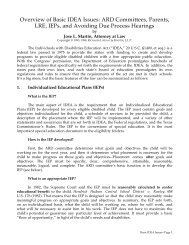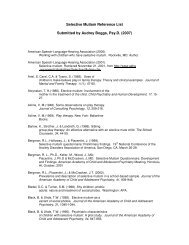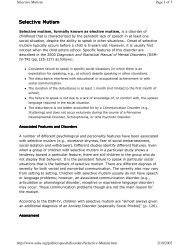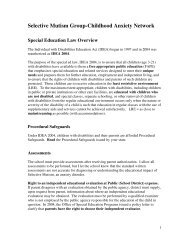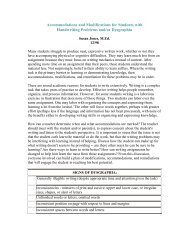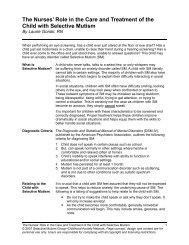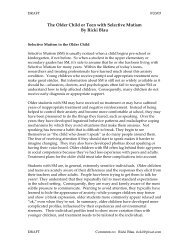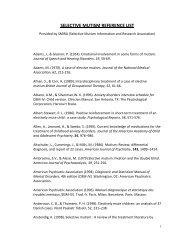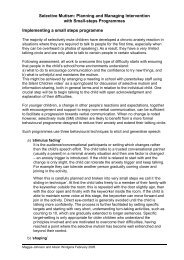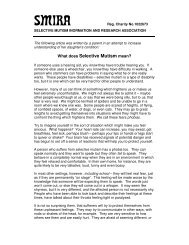Auditory Processing Disorder in Children What Does it Mean8
Auditory Processing Disorder in Children - Selective Mutism Group
Auditory Processing Disorder in Children - Selective Mutism Group
Create successful ePaper yourself
Turn your PDF publications into a flip-book with our unique Google optimized e-Paper software.
<strong>Aud<strong>it</strong>ory</strong> <strong>Process<strong>in</strong>g</strong> <strong>Disorder</strong> <strong>in</strong> <strong>Children</strong>: <strong>What</strong><strong>Does</strong> <strong>it</strong> <strong>Mean8</strong>By: National Inst<strong>it</strong>ute on Deafness and Other Communication <strong>Disorder</strong>s (2;;1)9n this article• <strong>What</strong> is aud<strong>it</strong>ory process<strong>in</strong>g?• <strong>What</strong> causes aud<strong>it</strong>ory process<strong>in</strong>g difficulty?• <strong>What</strong> are the symptoms?• How is <strong>it</strong> diagnosed?• <strong>What</strong> treatments are available?• Current research• Where can I learn more?<strong>What</strong> is aud<strong>it</strong>ory process<strong>in</strong>g8<strong>Aud<strong>it</strong>ory</strong> process<strong>in</strong>g is the term used to describe what happens when your bra<strong>in</strong> recognizes and <strong>in</strong>terpretsthe sounds around you. Humans hear when energy that we recognize as sound travels through the ear andis changed <strong>in</strong>to electrical <strong>in</strong>formation that can be <strong>in</strong>terpreted by the bra<strong>in</strong>. The "disorder" part of aud<strong>it</strong>oryprocess<strong>in</strong>g disorder (APD) means that someth<strong>in</strong>g is adversely affect<strong>in</strong>g the process<strong>in</strong>g or <strong>in</strong>terpretation of<strong>in</strong>formation.<strong>Children</strong> w<strong>it</strong>h APD often do not recognize subtle differences between sounds <strong>in</strong> words, even though thesounds themselves are loud and clear. For example, the request "Tell me how a chair and a couch arealike" may sound to a child w<strong>it</strong>h APD like "Tell me how a couch and a chair are alike." It can even beunderstood by the child as "Tell me how a cow and a hair are alike." These k<strong>in</strong>ds of problems are morelikely to occur when a person w<strong>it</strong>h APD is <strong>in</strong> a noisy environment or when he or she is listen<strong>in</strong>g tocomplex <strong>in</strong>formation.APD goes by many other names. Sometimes <strong>it</strong> is referred to as central aud<strong>it</strong>ory process<strong>in</strong>g disorder(CAPD). Other common names are aud<strong>it</strong>ory perception problem, aud<strong>it</strong>ory comprehension defic<strong>it</strong>, centralaud<strong>it</strong>ory dysfunction, central deafness, and so-called "word deafness."Back to top<strong>What</strong> causes aud<strong>it</strong>ory process<strong>in</strong>g difficulty8We are not sure. Human communication relies on tak<strong>in</strong>g <strong>in</strong> complicated perceptual <strong>in</strong>formation from theoutside world through the senses, such as hear<strong>in</strong>g, and <strong>in</strong>terpret<strong>in</strong>g that <strong>in</strong>formation <strong>in</strong> a mean<strong>in</strong>gful way.Human communication also requires certa<strong>in</strong> mental abil<strong>it</strong>ies, such as attention and memory. Scientistsstill do not understand exactly how all of these processes work and <strong>in</strong>teract or how they malfunction <strong>in</strong>cases of communication disorders. Even though your child seems to "hear normally," he or she may havedifficulty us<strong>in</strong>g those sounds for speech and language.
The cause of APD is often unknown. In children, aud<strong>it</strong>ory process<strong>in</strong>g difficulty may be associated w<strong>it</strong>hcond<strong>it</strong>ions such as dyslexia, attention defic<strong>it</strong> disorder, autism, autism spectrum disorder, specific languageimpairment, pervasive development disorder, or developmental delay. Sometimes this term has been misappliedto children who have no hear<strong>in</strong>g or language disorder but have challenges learn<strong>in</strong>g.Back to top<strong>What</strong> are the symptoms8<strong>Children</strong> w<strong>it</strong>h aud<strong>it</strong>ory process<strong>in</strong>g difficulty typically have normal heat<strong>in</strong>g and <strong>in</strong>telligence. However,they have also been observed to:• Have trouble pay<strong>in</strong>g attention to and remember<strong>in</strong>g <strong>in</strong>formation presented orally• Have problems carry<strong>in</strong>g out multistep directions• Have poor listen<strong>in</strong>g skills• Need more time to process <strong>in</strong>formation• Have low academic performance• Have behavior problems• Have language difficulty (e.g., they confuse syllable sequences and have problems develop<strong>in</strong>gvocabulary and understand<strong>in</strong>g language)• Have difficulty w<strong>it</strong>h read<strong>in</strong>g, comprehension, spell<strong>in</strong>g, and vocabularyBack to top=o> is <strong>it</strong> diagnosed8You, a teacher, or a day care provider may be the first person to notice symptoms of aud<strong>it</strong>ory process<strong>in</strong>gdifficulty <strong>in</strong> your child. So talk<strong>in</strong>g to your child's teacher about school or preschool performance is a goodidea. Many health professionals can also diagnose APD <strong>in</strong> your child. There may need to be ongo<strong>in</strong>gobservation w<strong>it</strong>h the professionals <strong>in</strong>volved.Much of what will be done by these professionals will be to rule out other problems. A pediatrician orfamily doctor can help rule out possible diseases that can cause some of these same symptoms. He or shewill also measure growth and development. If there is a disease or disorder related to hear<strong>in</strong>g, you may bereferred to an otolaryngologist, a physician who specializes <strong>in</strong> diseases and disorders of the head andneck.To determ<strong>in</strong>e whether your child has a hear<strong>in</strong>g function problem, an audiologic evaluation is necessary.An audiologist will give tests that can determ<strong>in</strong>e the softest sounds and words a person can hear and othertests to see how well people can recognize sounds <strong>in</strong> words and sentences. For example, for one task, theaudiologist might have your child listen to different numbers or words <strong>in</strong> the right and the left ear at thesame time. Another common audiologic task <strong>in</strong>volves giv<strong>in</strong>g the child two sentences, one louder than theother, at the same time. The audiologist is try<strong>in</strong>g to identify process<strong>in</strong>g problems.A speech-language pathologist can f<strong>in</strong>d out how well a person understands and uses language. A mentalhealth professional can give you <strong>in</strong>formation about cogn<strong>it</strong>ive and behavioral challenges that maycontribute to problems <strong>in</strong> some cases, or he or she may have suggestions that will be helpful. Because theaudiologist can help w<strong>it</strong>h the functional problems of hear<strong>in</strong>g and process<strong>in</strong>g and the speech-languagepathologist is focused on language, they may work as a team w<strong>it</strong>h your child. All of these professionalsseek to provide the best outcome for each child.
Back to top<strong>What</strong> treatments are available8Several strategies are available to help children w<strong>it</strong>h aud<strong>it</strong>ory process<strong>in</strong>g difficulty.• <strong>Aud<strong>it</strong>ory</strong> tra<strong>in</strong>ers are electronic devices that allow a person to focus attention on a speaker andreduce the <strong>in</strong>terference of background noise. They are often used <strong>in</strong> classrooms, where the teacherwears a microphone to transm<strong>it</strong> sound and the child wears a headset to receive the sound. <strong>Children</strong>who wear hear<strong>in</strong>g aids can use them <strong>in</strong> add<strong>it</strong>ion to the aud<strong>it</strong>ory tra<strong>in</strong>er.• Environmental modifications such as classroom acoustics, placement, and seat<strong>in</strong>g may help. Anaudiologist may suggest ways to improve the listen<strong>in</strong>g environment, and he or she will be able tomon<strong>it</strong>or any changes <strong>in</strong> hear<strong>in</strong>g status.• Language-build<strong>in</strong>g exercises can <strong>in</strong>crease the abil<strong>it</strong>y to learn new words and <strong>in</strong>crease a child'slanguage base.• <strong>Aud<strong>it</strong>ory</strong> memory enhancement, a procedure that reduces detailed <strong>in</strong>formation to a more basicrepresentation, may help. Also, <strong>in</strong>formal aud<strong>it</strong>ory tra<strong>in</strong><strong>in</strong>g techniques can be used by teachers andtherapists to address specific difficulties.• <strong>Aud<strong>it</strong>ory</strong> <strong>in</strong>tegration tra<strong>in</strong><strong>in</strong>g is sometimes promoted by pract<strong>it</strong>ioners as a way to retra<strong>in</strong> theaud<strong>it</strong>ory system and decrease hear<strong>in</strong>g distortion.It is important to know that much research is still needed to understand aud<strong>it</strong>ory process<strong>in</strong>g problems,related disorders, and the best <strong>in</strong>terventions for each child or adult. All the strategies undertaken will needto be su<strong>it</strong>ed to the needs of the <strong>in</strong>dividual child, and their effectiveness will need to be cont<strong>in</strong>uallyevaluated.Back to topCurrent researchIn recent years, scientists have developed new ways to study the human bra<strong>in</strong> through imag<strong>in</strong>g. Imag<strong>in</strong>gis a powerful tool that allows the mon<strong>it</strong>or<strong>in</strong>g of bra<strong>in</strong> activ<strong>it</strong>y w<strong>it</strong>hout any surgery. Imag<strong>in</strong>g studies arealready giv<strong>in</strong>g scientists new <strong>in</strong>sights <strong>in</strong>to aud<strong>it</strong>ory process<strong>in</strong>g. Some of these studies are directed atunderstand<strong>in</strong>g aud<strong>it</strong>ory process<strong>in</strong>g disorders. One of the values of imag<strong>in</strong>g is that <strong>it</strong> provides an objective,measurable view of a process. Many of the symptoms described as related to APD are describeddifferently by different people. Imag<strong>in</strong>g will help identify the source of these symptoms. Other scientistsare study<strong>in</strong>g the central aud<strong>it</strong>ory nervous system. Cogn<strong>it</strong>ive neuroscientists are help<strong>in</strong>g to describe howthe processes that mediate sound recogn<strong>it</strong>ion and comprehension work <strong>in</strong> both normal and disorderedsystems. Research <strong>in</strong>to the rehabil<strong>it</strong>ation of child language disorders cont<strong>in</strong>ues. In the future, both basicand cl<strong>in</strong>ical research will help us better understand the nature of aud<strong>it</strong>ory process<strong>in</strong>g disorders.Back to topWhere can 9 learn more8If you have questions, contact us at the NIDCD Information Clear<strong>in</strong>ghouse1 Communication AvenueBethesda, MD 2;Z[2-345_Toll Free: (Z;;) 241-1;44TTY: (Z;;) 241-1;55
E-mail: nidcd<strong>in</strong>fo`nidcd.nih.govInternet: www.nidcd.nih.govContact the follow<strong>in</strong>g group for <strong>in</strong>formation related to audiology and audiology professionals andservices.American Academy of AudiologyZ3;; Greensboro Drive, Su<strong>it</strong>e b5;McLean, cA 221;2coice: (b;3) b[;-Z4__Toll-free: (Z;;) AAA-233_TTY: (b;3) b[;-Z4__Internet: www.audiology.orgOr, for <strong>in</strong>formation related to audiology and speech-language pathology professionals and services,contactAmerican Speech-Language-Hear<strong>in</strong>g Association1;Z;1 Rockville PikeRockville, MD 2;Z52coice: (3;1) Z[b-32b[Toll-free: (Z;;) _3Z-Z255Hours: Z:3; a.m.-5 p.m., eastern timeTTY: (3;1) Z[b-;15bFax: (3;1) Z[b-b355E-mail: actioncenter`asha.orgInternet: www.asha.orgFor more <strong>in</strong>formation, contact the NIDCD Information Clear<strong>in</strong>ghouse.Back to topNational Inst<strong>it</strong>ute on Deafness and Other Communication <strong>Disorder</strong>s, NIH Pub. No. ;1-4[4[ March 2;;1http://www.ldonl<strong>in</strong>e.org/article/Z;5_?themeepr<strong>in</strong>tf2;;_ WETA. All Rights Reserved.



